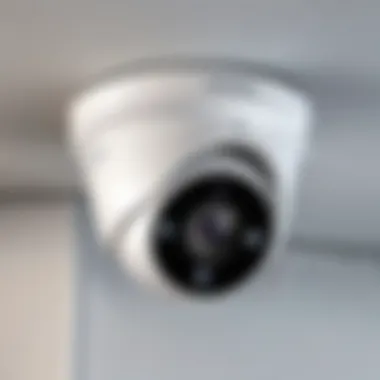Exploring Easy WiFi Security Cameras for Home Safety


Intro
The increasing reliance on technology has significantly shaped the way we approach home security. Easy WiFi security cameras have gained traction as efficient tools for monitoring properties. With straightforward installation processes and accessible pricing, these devices offer a sense of safety and peace of mind.
This article delves into the essential aspects of easy WiFi security cameras, covering their features, advantages, and the considerations necessary for making informed choices. Understanding these cameras' practicalities can aid you in selecting the equipment that aligns with your safety needs.
As we explore the topic, we will dissect the advantages these cameras bring to home security. This includes seamless integration with smart home systems, the flexibility of remote monitoring, and intuitive interfaces that appeal to various users. By highlighting the significance of technical specifications and performance analysis, you will gain insights into optimization and usage in real-world scenarios.
Foreword to WiFi Security Cameras
WiFi security cameras have fundamentally altered the way we think about home and business security. Their rise in popularity can be attributed to both technological advancements and growing concerns over safety. These cameras offer an affordable, user-friendly solution for monitoring spaces remotely. In this section, we will explore the significance of WiFi security cameras, outlining their benefits, considerations, and the critical role they play in modern security systems.
One of the primary advantages of WiFi security cameras is their ease of installation. Unlike traditional wired systems which require complex setups, many WiFi cameras are designed for plug-and-play functionality. Users can often set them up in a matter of minutes, making them accessible even to those with limited technical expertise. This convenience has contributed to their widespread adoption among homeowners and businesses alike.
"Easy installation is not just a feature; it is a necessity in today's fast-paced world."
The importance of connectivity cannot be understated. WiFi cameras leverage existing internet infrastructure, permitting real-time viewing and alerts via smartphones, tablets, or computers. This level of accessibility is critical for maintaining vigilance over one’s property, particularly for remote monitoring. With mobile applications, users can monitor live feeds, receive notifications of unusual activity, and even communicate through two-way audio in certain models. This interactivity enhances the ease with which individuals manage their security.
Security is also paramount when discussing WiFi cameras. In an age where home invasion and property theft are concerning issues, these devices provide peace of mind. Users can actively participate in their own safety protocols. However, customers must approach the selection and use of these cameras with due diligence. Different products have different capabilities and security features, which can dramatically impact their reliability and effectiveness.
Additionally, while WiFi security cameras are generally cost-effective, the pricing spectrum is broad. From entry-level options to high-end models with advanced features, consumers have a range of choices. This affordability allows individuals to customize their security systems according to their needs without extensive financial burden.
In summary, WiFi security cameras serve a crucial role in contemporary security strategies, combining convenience, accessibility, and cost-effectiveness. As we move through the subsequent sections, we will delve deeper into the benefits, installation processes, features, challenges, and future trends associated with these devices. This exploration will provide invaluable insights to IT professionals and tech enthusiasts alike.
Benefits of WiFi Security Cameras
In today's world, the value of security cameras cannot be underestimated. More people recognize the importance of WiFi security cameras. These devices play a crucial role in safeguarding homes and properties. They provide benefits that address the needs of modern security solutions. Understanding these advantages helps consumers make informed choices.
Convenience and Accessibility
WiFi security cameras offer significant convenience. They are simple to install, often requiring just a power source and a stable WiFi connection. This means that even those without technical skills can set up their cameras with relative ease. Many devices have user-friendly apps. With these apps, users can access live feeds from their cameras at any time. Thus, monitoring becomes easier than ever. The easy access through mobile devices promotes a sense of control over one’s security.
Moreover, the portability of these cameras is another advantage. Users can relocate these devices without hassle, adapting to changing security needs. Whether at home or on the go, accessibility is a key feature that enhances the overall utility.
Affordability and Cost-Effectiveness
The cost of WiFi security cameras has dropped significantly in recent years. Today, there are various models available to fit different budgets. This affordability expands access to security technology, allowing homeowners to invest in protection without breaking the bank.
Additionally, these devices often have low operational costs. Many come with features that do not require ongoing monthly fees for basic usage. Users can store recordings on local storage or use free cloud options, minimizing expenses. As a result, investing in WiFi security cameras can be more cost-effective compared to traditional CCTV systems that may involve extensive installation fees and ongoing maintenance.
Remote Monitoring Capabilities
One of the standout features of WiFi security cameras is their remote monitoring capabilities. Users can check the live feed from anywhere, thanks to advancements in mobile technology. This real-time access provides peace of mind, reducing anxiety related to potential security threats.
The functionality extends beyond simple viewing. Many modern cameras offer notifications when motion is detected. This prompt alerts users to any unusual activity in and around their properties. Furthermore, high-quality recordings enable clear visibility, ensuring that nothing goes unnoticed. Remote access empowers users, allowing for timely responses to security issues.
Remote monitoring capabilities are a game-changer. They transform passive surveillance into active protection.
In summary, the benefits of WiFi security cameras significantly enhance home security. Their convenience, affordability, and remote monitoring features cater to the needs of users in a fast-paced world. As technology evolves, these devices continue to play a vital role in personal safety and property protection.
Key Features of Easy WiFi Security Cameras


Understanding the key features of easy WiFi security cameras is crucial for anyone looking to enhance their home security. These characteristics not only determine the functionality and effectiveness of the cameras but also influence the user experience. Evaluating these features empowers consumers to make informed decisions that align with their specific needs.
Resolution and Image Quality
Resolution is a primary consideration when selecting a WiFi security camera. Higher resolution provides clearer imagery, enabling users to identify faces, numbers on a vehicle, or other important details. A resolution of 1080p is common and provides satisfactory clarity. For critical areas where detail is essential, users should look for cameras offering 4K resolution. It's important to remember that higher resolution cameras demand more bandwidth and data storage. Therefore, plan accordingly based on your internet speed and storage capacity.
Field of View and Pan-Tilt-Zoom
The field of view is another important feature. A camera with a wide field of view can cover more area, reducing the number of cameras needed for complete coverage. Usually, a field of view around 130 degrees is ideal for residential settings. Meanwhile, cameras equipped with pan-tilt-zoom capabilities offer additional versatility. Users can adjust the camera’s orientation and zoom in on areas of interest remotely. This flexibility can be especially helpful for monitoring large properties or high-traffic zones.
Night Vision Capabilities
Night vision capabilities are essential in ensuring security cameras function properly around the clock. Many modern cameras use infrared technology to capture images clearly in low-light conditions. Look for cameras that specify the distance at which they can operate effectively in darkness. Some models even offer color night vision features, which can be advantageous for distinguishing details during nighttime surveillance.
Audio Features
Audio features enhance situational awareness significantly. Cameras that include two-way audio allow users to communicate through the camera. This feature not only adds an extra layer of security but also enables interaction with delivery personnel or visitors. Additionally, cameras equipped with built-in microphones can capture sounds, providing a more complete audio-visual context during an event.
Always consider how these features will fit into your overall security strategy and technical capabilities.
Understanding these key features can facilitate smarter choices regarding WiFi security cameras. This knowledge empowers potential buyers to select systems that meet their specific requirements.
Installation Process for WiFi Security Cameras
The installation process for WiFi security cameras is a critical element in the successful deployment of these devices. Proper installation sets the foundation for a reliable and effective security system. When done correctly, it enhances the utility of the camera, allowing homeowners to enjoy the benefits of remote monitoring and improved security. It is essential to consider the elements involved in the installation to avoid future complications.
Selecting the Optimal Location
Choosing the right location for your WiFi security camera is paramount. Consideration should be given to visibility and coverage. Positioning a camera in a high, unobstructed location can ensure wide coverage of the premises. Common areas for installation include entries, driveways, and backyards.
Some specifics to remember when selecting a location:
- Field of View: Ensure the camera has a clear view of key areas, avoiding obstructions like trees or walls.
- Distance from WiFi Router: Keep the camera within a good range of the WiFi router to maintain a strong connection.
- Lighting Conditions: Avoid areas with extreme lighting fluctuations. For instance, placing a camera directly in front of a bright light source can impair its ability to capture clear images.
Connecting to WiFi Networks
Connecting the camera to your WiFi network is a fundamental step in getting your security camera operational. This process can differ by camera model, but typically involves the following steps:
- Download the App: Most modern WiFi cameras come with a dedicated application for setup. Download it from a trusted source.
- Power the Camera: Ensure the camera is plugged in and powered on before starting the connection process.
- Follow Instructions: Using the app, follow the on-screen instructions for connecting the camera to your home WiFi network. This usually involves entering the WiFi password.
- Test the Connection: After connecting, conduct a quick test to ensure that the camera is properly linked to the network. Check the live feed via the app.
Mounting and Positioning Guidelines
Mounting the camera properly ensures stability and optimal functionality. Here are some guidelines to follow:
- Use the Right Tools: Have a drill, screws, and a level handy for an accurate installation. Some brackets may come with the camera.
- Secure Mounting: Attach the camera firmly to the wall or ceiling. Check that it won’t easily dislodge or swing out of position.
- Adjust the Angle: After mounting, adjust the camera to the desired angle, ensuring maximum coverage.
- Weatherproofing: For outdoor cameras, ensure the mounting method is resistant to weather. Check for a tight seal to prevent moisture ingress.
"Proper installation of WiFi security cameras is not just about placement; it is about ensuring function and accessibility."
Challenges in Using WiFi Security Cameras
The integration of WiFi security cameras into modern home security systems offers numerous benefits. However, these devices also come with their set of challenges that users should be aware of. Understanding these challenges is crucial for making informed decisions when selecting and installing a WiFi security camera. This section discusses three primary challenges: internet reliability concerns, privacy issues, and potential vulnerabilities to hacking.


Internet Reliability Concerns
WiFi security cameras rely on a stable internet connection to function properly. Without a strong and reliable connection, users may experience issues like interruptions or glitches in video feeds.
When connectivity is poor, access to live streams may be limited. This aspect is critical for users who rely on real-time monitoring for safety. Here are some factors that can influence internet reliability:
- Distance from Router: The distance between the camera and the WiFi router can affect the strength of the signal. The further away the camera is located, the weaker the signal may be.
- Network Congestion: Too many devices connected to the same network may cause congestion, affecting the camera's performance.
- Obstacles: Physical barriers such as walls and furniture can block signals, leading to a drop in performance.
To mitigate these issues, it is advisable to position the camera closer to the router or utilize range extenders to boost the signal.
Privacy and Surveillance Issues
As WiFi security cameras monitor properties, they inherently raise privacy concerns. Various stakeholders may feel uncomfortable with constant surveillance in both residential and shared environments. Here are some key points to consider:
- Location of Installation: Cameras installed in shared spaces, such as hallways or near windows, may record activities of visitors or neighbors, leading to potential ethical dilemmas.
- Data Sharing: Users should consider how their camera data might be stored and who has access to it. Many cameras use cloud services, which can raise concerns about data breaches.
"Privacy by design should be the default for all security camera systems."
This caution reflects the need for transparency in how recordings are managed. Users should read the privacy policies provided by manufacturers and select models with robust privacy settings.
Potential Vulnerabilities to Hacking
WiFi security cameras can also be vulnerable to hacking. As they connect to the internet, they may become targets for cybercriminals. Here are notable vulnerabilities:
- Weak Passwords: Many users fail to update default passwords, making their cameras easy targets for hackers.
- Outdated Firmware: Manufacturers often release updates to patch security vulnerabilities. Using outdated firmware can leave devices exposed.
- Configuration Issues: Inadequate network settings can further expose devices to unauthorized access.
To combat these vulnerabilities, users should establish strong, unique passwords and regularly check for firmware updates. They may also consider using secure networks, such as virtual private networks (VPNs), to further protect their data.
In summary, while easy WiFi security cameras enhance home security, users must navigate several challenges. Addressing internet reliability, privacy concerns, and potential hacking risks will help maximize the benefits of these devices.
Comparative Analysis of Top WiFi Security Cameras
In the world of home security, WiFi cameras come in various shapes and functionalities, making it essential for consumers to evaluate their options. The comparative analysis of top WiFi security cameras serves a critical role in guiding potential buyers through this labyrinth of features and prices. By breaking down the differences between products, users can align their choices with specific needs and financial constraints.
Key considerations in this analysis include:
- Price Range: Understanding which cameras fall into entry-level, mid-range, or premium categories is vital. Each range may offer different functionalities that suit various scenarios.
- Features: Not all cameras are created equal. Some may offer only basic motion detection, while others provide advanced AI capabilities and cloud storage.
- User Reviews: Insights from actual users lend credibility to product claims, revealing real-world strengths and potential weaknesses.
This comparative analysis arms buyers with the knowledge to make an informed decision, potentially safeguarding their homes without overspending or compromising on required features.
Entry-Level Options
Entry-level WiFi security cameras are designed for individuals or families seeking basic security solutions without breaking the bank. One key forte of these models is their simplicity. They are typically easy to install and use. Moreover, they offer basic functionalities such as:
- 720p or 1080p video resolution
- Motion detection alerts
- Basic mobile app access
Models like the TP-Link Tapo C100 provide a cost-effective solution by incorporating essential features without complex settings. However, users may need to forgo advanced features like substantial storage or high-quality night vision.
Mid-Range Solutions
Mid-range options strike a balance between affordability and functionality. They often include several additional features that can be particularly beneficial for those who need more than just basic monitoring. Key components to consider are:


- 1080p or higher video quality
- Two-way audio functionality
- Improved night vision
For instance, the Ring Stick Up Cam provides enhanced tech elements, integrating well with smart home systems. Users often find these cameras valuable because they combine quality with user-friendly app interfaces, allowing remote monitoring with ease.
High-End Choices
High-end WiFi security cameras are tailored for those who demand comprehensive surveillance capabilities. Their price reflects sophisticated features and extended functionalities. Common attributes include:
- 4K video resolution
- AI-powered features such as person detection
- Extensive cloud storage options
The Arlo Ultra, for example, showcases premium features such as color night vision and an integrated spotlight. This camera appeals to tech enthusiasts and professionals who require a top-tier solution for comprehensive property monitoring. The investment might be significant, but it generally ensures higher reliability and cutting-edge technology.
"Investing in the right WiFi security camera can make a significant difference in your home monitoring capabilities and peace of mind."
Future Trends in WiFi Security Cameras
The realm of WiFi security cameras is continuously evolving. Understanding future trends is vital for individuals and organizations seeking to enhance their security measures. These trends reflect technological advancements and changing consumer expectations. Organizations must stay informed to keep their security infrastructure robust and effective.
Integration with Smart Home Systems
Smart home systems offer a cohesive approach to home automation and security. WiFi security cameras are increasingly being integrated into these systems. This offers users a seamless experience where they can control multiple devices from one platform. Devices such as Amazon Alexa, Google Home, and Apple HomeKit provide interoperability that enhances functionality.
Benefits of this integration include:
- Centralized Control: Users can manage security cameras, lights, and alarms from a single application, leading to improved user experience.
- Enhanced Automation: Cameras can trigger alarms or lock doors when certain conditions are met, improving safety.
- Remote Access: Users can receive real-time alerts and control functions from anywhere, adding convenience.
This trend is likely to grow further as more homeowners adopt smart home technologies. Integration allows for better resource management and simplifying complex security protocols.
Advancements in AI Technology
Artificial Intelligence is transforming how we use WiFi security cameras. AI enhances features like motion detection, facial recognition, and behaviour analytics. These improvements lead to more precise monitoring and reduced false alarms.
Key advancements include:
- Facial Recognition: Cameras can identify residents and alert on unrecognized faces. This feature adds a layer of personal security.
- Smart Alert Systems: Instead of generic alerts, AI systems can differentiate between familiar and unfamiliar activities. This reduces the number of irrelevant notifications.
- Predictive Analytics: By analyzing patterns, AI can help predict potential security breaches. This proactive measure enhances preparedness.
With AI technology advancing, the capabilities of WiFi security cameras are likely to expand. The focus will shift toward making surveillance more intelligent and user-friendly, ensuring higher safety levels. Utilizing AI can streamline security management for both residential and commercial properties.
Closure
When evaluating the effectiveness and relevance of easy WiFi security cameras, one must consider their role in modern home security. As technology has advanced, these cameras have become not only accessible but also essential for ensuring property safety and enhancing peace of mind. With a myriad of options on the market, it is critical to make an informed decision that aligns with individual needs and circumstances.
Making an Informed Choice
To make a wise choice, several factors need to be assessed:
- Camera Specifications: Look at resolution, field of view, and night vision capabilities. Higher specifications often correlate with better quality surveillance.
- Installation Requirements: Consider how easy it is to install the cameras. Choose models that suit your technical comfort level.
- Integration with Existing Systems: If you already use smart home devices, find cameras compatible with them. This integration enhances functionality and convenience.
- Budget Constraints: Security should not break the bank. Evaluate different price points and weigh features against cost.
Each of these elements plays a part in ensuring that your security needs are met effectively.
Final Thoughts on Security
In an era where security threats continuously evolve, being proactive is more important than ever. Easy WiFi security cameras serve as powerful tools in this proactive approach. They provide not only visual deterrents against potential intrusions but also allow for real-time monitoring from anywhere via smartphones or computers. However, one must remain vigilant about cybersecurity. Regularly updating firmware and using strong, unique passwords can protect against unauthorized access.
"The best security is not just about having the right devices, but also about understanding how to use them effectively."
Ultimately, investing time to understand the various aspects of WiFi security cameras yields substantial benefits, ensuring that your home remains a safe haven.



